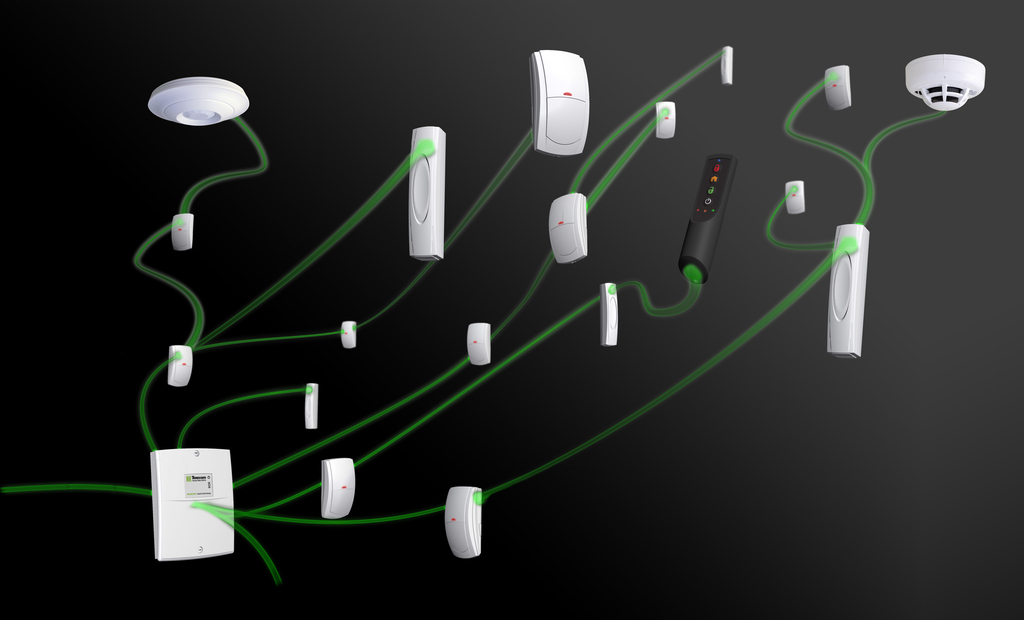
Brian Sims
Editor

Brian Sims
Editor
The race for better wireless security systems is on and as such better technology is hitting the market. Clym Brown reviews latest developments and explains how technology is creating a new generation of wireless security equipment.
IN THE security sector, wireless devices are now commonplace, and with good reason. Gone are the days of frustratingly intermittent connections, poor product performance and questionable reliability. With advancements in modern wireless chipset technology, electronic security manufacturers have all the tools needed to deliver stable, robust and quality wireless products.
Battery powered security devices offer obvious advantages over their hard-wired counterparts. With speed of installation dramatically improved, greater freedom on product positioning, avoidance of damage to property, minimum disruption to the property owner, reduction of copper wiring and further advantages when upgrading or refurbishing, it is clear to see why wireless is one of the security industry’s fastest growing market segments.
Whereas the security industry has memories of unreliable wireless products causing major problems in the past, the fact is that most building owners nowadays expect wireless products to perform. With the exponential rise of smart devices, users are increasingly technology savvy and have no qualms in acquiring a wireless security system. On the surface, it simply makes sense.
Previous limitations
Before chipset manufacturers started to provide ‘all in one’ wireless transceivers, the quality of wireless systems varied enormously. Quality RF design engineers were few and far between, as demonstrated by the lack of quality and performance of early wireless systems. Despite being more expensive than wired equipment, wireless systems were initially developed for residential applications where the performance requirements were less demanding.
Even today, the majority of wireless systems are designed for, and installed in, residential applications. The quality of wireless design has improved over time and robust, reliable wireless products are now common.
The same cannot be said for commercial applications, where the expectation of performance placed on electronic security equipment is far greater than in residential installations. The environments are often harsher, the number of devices and size of area requiring protection are greater, and the risk (and potential cost) of a security incident is significantly higher. In such situations, even the latest standard wireless devices can suffer adverse performance issues. These include:
Inadequate device performance.Battery powered wireless devices need to conserve power to maintain battery life. In order to minimise power usage, wireless devices typically spend the majority of time ‘asleep’. This can compromise device performance when compared to commercial-grade hard-wired devices.
Range limitations.Commercial premises can be large in size and can be constructed from materials where radio signals are substantially reduced. These factors limit the available coverage by a standard wireless solution.
Point-to-point communications.With only one wireless signalling path available, typical wireless devices are susceptible to being ‘cut-off’ if there are changes to the building infrastructure. Even something as simple as the addition of a metal filing cabinet could cause disruption to wireless signalling.
Limited number of devices. Commercial premises can be large installation sites, requiring more devices than many wireless systems are able to accommodate.
Limited number of device types. With the power-conscious nature of wireless devices, products that typically require more power are rarely available.
Complex site surveys. In order to professionally verify the positioning and reliability of wireless communications, it is generally best practice to perform a site survey. This usually requires the site to be evaluated using diagnostic equipment in order to determine the suitability for wireless devices – defeating the intent of wireless being quicker and simpler to install.
Next-generation
For reliable wireless systems in commercial applications, a combination of intelligent system design and specification of higher-grade products is required. With careful selection and consideration, next-generation wireless systems are now providing significant benefits, even in harsher environments. These include:
Hybrid systems. Combining quality wire-free equipment with established hard-wired products creates a ‘best-of-both-worlds’ scenario. Where cabling access is difficult to deploy, or where the wireless performance is less challenging, the benefits of wire-free technology can be used. Where the wireless performance is too demanding, or the particular device requirements are not available in wireless form, hard-wired products are specified instead.
Powered repeaters. To overcome the range limitations of point-to-point wireless communications, many manufacturers offer systems that utilise powered repeaters. These are, as the name suggests, powered devices that receive wireless communications from wireless devices and repeat the information to the control panel, usually across a wired network. By using multiple powered repeaters the wireless coverage is increased, as well as the overall number of wireless devices.
There are many different implementations and derivatives of this technique available from different manufacturers. Each will advocate the virtues of their particular implementation, but whether described as ‘nodes’, ‘hubs’ ‘portals’, ‘clusters’, ‘expanders’ or otherwise, they tend to be variations on the same theme.
Mesh-network technology.This is a more recent technological advancement in wireless security systems. It is where each individual battery-powered wireless device is capable of acting as a repeater, receiving and repeating wireless transmissions from other devices. In this scenario, the size, scalability and range of the entire wireless security system are extended, as wireless signalling is no longer restricted by point-to-point communications.
By having every single device in a system capable of retransmitting wireless communications, there are significant improvements in reliability, even when compared to using powered repeaters. The powered repeater solution will still depend on limited point-to-point communications. With mesh networking, the number of available wireless transmission routes is dependant on the number of installed devices. As more and more devices are installed, more and more signalling routes become available, exponentially increasing the number of signalling options and the integrity of the entire wireless system.
Conclusion
Wireless security systems have become mainstream in residential installations due to the quality of wireless communication components available to electronic security manufacturers today. With point-to-point wireless systems becoming reliable, robust, bi-directional and with increased range, the majority of residential systems can be covered with ease.
In commercial systems wireless security is much less commonplace. A limited number of suitable devices are available and in many cases the reliance on point-to-point wireless communications introduces an unacceptable risk.
However, with increasing advancements in wireless and digital communication technologies, and the proliferation of wireless device types and cloud solutions, commercial grade wireless systems are becoming difficult to ignore as an installation option. The advantages of using wireless products are as relevant to the commercial sector as it is in residential applications, and wireless limitations are diminishing as technologies continue to advance.
That said, end users would be wise to undertake a risk / benefit analysis before deciding to use certain wireless systems. There are still limitations to be considered; limitations that may be exposed in more complex and challenging installations.
The rate of technology advancements continues apace, with new wireless and digital technologies and product offerings being considered ‘game-changing’ in terms of reliability and performance. It is time for security companies to embrace these advances and provide appropriate technology to their commercial customers. In this way the security industry will do more than simply keep itself relevant – it will continue to be an essential part of people’s lives in the years to come.
Clym Brown, is marketing director at Texecom. For more information, visit www.texe.com



